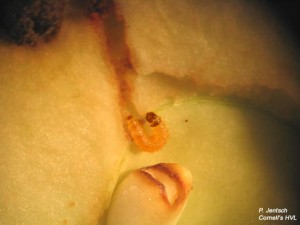
European corn borer (ECB) Ostrinia nubilalis: When it comes to apple production we typically don’t concern ourselves with the likes of European corn borer. However, this insect, especially in years of drought can cause considerable damage to newly planted trees. Populations began in relatively low numbers throughout NY State this season but will likely continue to climb over the next few weeks. In new plantings we have seen ECB begin to burrow into the growing shoots over the past week so scouting should begin in newly planted trees this weekend.
Female ECB moths have begun laying egg masses on the underside of apple leaves with larva hatch observed. If ECB is present, larval feeding should become evident in newly developing apple shoots over the next few days. You will see brown frass and ooze where the leaf petiole and stem join. It is likely that fruit trees with ECB injury will have higher damage levels along the perimeter, especially where tall grasses and woody stemmed broad leaf weeds are present.

The Eastern strain of European corn borer (New York / Eastern Z strain) has a wide host range, attacking robust herbaceous plants with a stem large enough for the larvae to enter.
Some of the common weeds infested include barnyardgrass, Echinochoa crus-galli; beggarticks, Bidens spp.; cocklebur, Xanthium spp.; dock, Rumex spp.; jimsonweed, Datura spp.; panic grass, Panicum spp.; pigweed, Amaranthus spp.; smartweed, Polygonum spp.; and others.
There are reports that weather influences European corn borer survival. Heavy precipitation during egg hatch is sometimes an important mortality factor. Low humidity, low nighttime temperatures, and heavy rain and wind are detrimental to moth survival and oviposition. However, like most insect pests, they seem to thrive during unlikely weather scenarios in years past. Drought seems to favor development and generational success.

Typical examples of ECB feeding on apple is similar to that of Oriental Fruit Moth on apple with frass and entry under petiole or side of new shoots.
From our observations today the larva are residing within the upper most part of the shoot, 8-10 inches from the tip. Frass is visible at the base of the petiole and leaves are browning from the tip back toward the stem of infected stem portions (see images below).
Applications of most insecticides will do little to manage the larva within the tree. However, management now will reduce further infestations in blocks that already show the beginnings of ECB boring and larval feeding.
Delegate 25WG is labeled for use on apple in NY and is very effective at controlling ECB on newly planted trees. Bt formulations are also labeled for ECB, and may require tight intervals for acceptable management during periods of intense sunlight and heavy weathering.
Insecticides used against codling moth at this time will likely impact ECB, however, newly planted trees that have no marketable crop are often ignored as mature trees with fruit near harvest, and concerns over CM and apple maggot infestations to the crop distract growers from attending to new plantings. Management of ECB to reduce shoot injury to newly planted trees will require a specific management plan and no less then bi-weekly applications of effective insecticides to maintain terminal shoot growth during ECB hatch.
2016 Trap Captures and Additional ECB Images:(Click on images for expanded view)
Trap sites across NYS show very low early season adult flight.Later into the season we are now finding increasing ECB adults in pheromone traps across the state that will likely require intensive management on sweet corn.
Newly planted apple should be scouted frequently, especially if drought conditions continue during the latter part of the summer.
Irrigated apple become very attractive to ECB adults as they move out from low moisture weed hosts along orchard borders. Pheromone trap placement for ECB in newly established orchards should be along the edge where know weed host plants reside.











